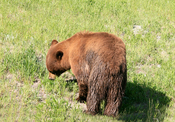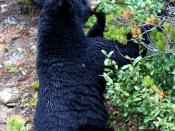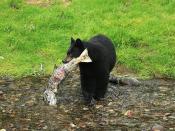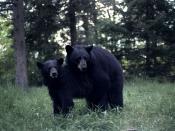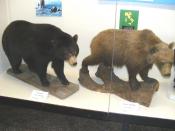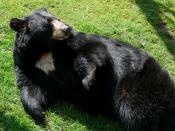The "Bear" Essentials Whether in the Appalachian Mountains or the Nevada sierra, many American forests are home to one of nature's most fascinating animals, ursus americanus, or "American Bear," according to the Encyclopedia Britta nica. More commonly known as the black bear, this animal's passive demeanor often disguises its potential to be threatening, and even deadly, to their human counterparts. Unfortunately, most attacks occur because the black bear remains one of the most misunderstood mammals in the forest.
There are many misconceptions about black bears and about how a person should handle an encounter with these creatures. Knowing what not to do during an encounter with a black bear is as equally important as knowing what to do. The following list of "do's" and "don'ts" could prevent a fun day in the forest from turning to tragedy.
First of all, don't run. If you come face-to-face with a black bear, your first instinct will probably be to run.
However, bears have been clocked running at speeds up to thirty-five miles per hour, according to Discovery Channel Online. Running from a bear may only encourage a chase, and a chase will most likely end in an attack. The fastest human cannot match a bear's speed, much less an average hiker or hunter.
Second, don't play dead. Black bears eat meat, including carrion (dead things). Even if the bear is not hungry, they are so curious they may rip a person open simply to see what is inside. In one documented attack, a woman played dead while her husband ran for help. He returned to find no trace of her or the bear (Discovery Online). Playing dead only encourages aggression in a black bear.
Third, don't climb a tree. Although black bears are bulky animals and may seem clumsy, they are actually nimble tree climbers. Black bears are often observed sleeping in high tree branches. In fact, bear's claws grow in excess of one inch which allows for excellent traction in climbing. Hence, trying to escape a bear by climbing up a tree may simply leave you cornered.
Fourth, don't detour from marked trails. The US Scouting Association advises that only the most skilled hikers and hunters should ever detour from marked trails. Bears tend to stay away from trails that are frequented by humans. A common misconception is that black bears hibernate in caves the entire winter season. Black bears often forage in the wintertime, and can often be found sleeping in shrubs or thickets.
Fifth, don't wear colognes or perfumes. Bears have a very sensitive sense of smell.
Most people know that bears are attracted to the smell of food. However, bears are also attracted to other distinct odors, including cologne and insect repellents, often causing hunters to become the hunted. According to "Black Bear Facts" online, a woman on a camping trip to the Smoky Mountains awoke one night to a bear licking cold cream from her face. Although bears are not tropical animals, they will undoubtedly pursue the scent of coconut tanning oil.
Since we have established that a person should not run, play dead, or climb a tree when encountering a black bear, one might ask, "What should I do?" Following is a list of "do's" when encountering a black bear. These tips could make all the difference between seeing a bear and being attacked by one.
First of all, do pray. It can't hurt, but don't save it as a last resort either. Second, do remain calm. Knowing a bit about bear behavior may keep you rational when face-to-face with a bear. For example, the American Bear Association claims that when a bear raises upon it's back feet, it is only being curious and that it will not attack. Also, bears can sense fear in humans, so a panicking person is more likely to be attacked than a calm one.
Third, do make noise. Bears feel threatened if they are surprised, and are more likely to attack. Whistling, talking loudly, and using noisemakers such as horns are ideal for alerting a bear of your presence. Most bears will avoid noisy humans (Stevens).
Fourth, do keep your distance. Black bears should only be observed from a distance. Many people get into trouble because they approach bears out of curiosity or to take pictures. When observing a bear, a safe, circular distance should be maintained around the bear. A bear should never be crowded or cornered. If the bear becomes aware of your presence, you should remain still and quiet unless the bear begins to approach. If the bear approaches, you should shout toward the bear. Shouting out warnings as simple as "Go away!" and "Get bear!" has saved people's lives (National Geographic Online).
How likely is a black bear to attack a human? According to The American Bear Association a person is 180 times more likely to be stung by a bee and 180,000 more times likely to die in a car wreck. Despite thousands of bear encounters each year, less than one person every three years is killed by a black bear. Sharing the "Bear Essentials" with fellow hikers may make these statistics even larger, and help humans coexist more harmoniously with North America's "gentle giant."
